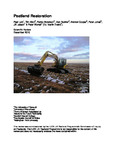Peatland Restoration. Report to IUCN UK Peatland Programme.
| dc.contributor.author | Lunt, P., Allott, T., Anderson, P., Buckler, M., Coupar, A., Jones, P., Labadz, J. & Worrall, P. (2010) Peatland Restoration. Report to IUCN UK Peatland Programme. Edinburgh, | |
| dc.date.accessioned | 2021-08-09T14:59:54Z | |
| dc.date.available | 2021-08-09T14:59:54Z | |
| dc.date.issued | 2010-12 | |
| dc.identifier.uri | http://hdl.handle.net/10026.1/17517 | |
| dc.description.abstract |
The focus of this review paper is on peatland restoration, in particular what are the policies, present drivers and examples of best practice within the UK. The aim is to review opportunities and constraints to peatland restoration and make recommendations which could be used to inform future policy. Peatlands are wetlands in which restoration typically has three main aims. Firstly, to manage vegetation more effectively to restore sites and their conservation features to favourable condition; secondly, where feasible, to restore peat formation; and finally appropriate management of water (chiefly peat wetness, but also water quality, runoff volume and timing) Vegetation management occurs on a continuum from the vegetation of bare peat, to projects aimed at restoring appropriate plant community composition. In UK peatlands, targets for restoration have largely focused on achieving favourable nature conservation status on protected sites. In recent years, with the involvement of water companies and the movement up the political agenda of peatlands as potential carbon stores, attention has focused on large area restoration projects in the uplands. Results suggest that rewetting has been achieved by the blocking of 1000s of kilometres of drainage ditches. Considerable gains to biodiversity and reductions in carbon loss have been made over large areas by reduction in grazing animal stock densities and removal of burning management. In upland and lowland peatlands, successful restoration following tree removal has been achieved where it has been possible to return the hydrological dynamics to the pre-plantation state. However in many afforested, drained and burnt over sites, oxidation and compression of surface peat layers has resulted in changes in hydrological function, increasing the risk of invasion from undesirable plant species and the loss of Sphagna. A major problem limiting what we know about the success of peatland restoration is the absence of long-term monitoring data. Post restoration monitoring shows that recovery of water levels is possible in a relatively short time frame (2-5 years) Many restoration projects show short term negative impacts on surface water quality and methane generation but, where data exist, positive responses in the medium to long term. Restoration of target mire vegetation in response to management may take several decades to achieve with agriculturally improved and heather dominated peatlands presenting the greatest challenges. Restoring appropriate Sphagnum species and cotton grasses is vital to restoring peat forming processes and securing UK peatlands as both secure long-term stores of carbon and also future carbon sinks. In addition to the literature, this review draws upon information gathered from the Peat Compendium and workshops involving expert consultees, which were carried out as part of the review. During workshops there was a great deal of consensus on what could and could not be achieved using existing restoration techniques. Also presented within the paper are a series of knowledge gaps and uncertainties. An important point of agreement was that the most convincing argument for the funding of future restoration projects could be made using the multiple objectives of carbon sequestration, water management and biodiversity gain. However a significant future challenge is to understand how various climate scenarios, such as increased temperatures, summer droughts and higher intensity rainfall events are likely to affect peatlands. In particular it was agreed that the lowering of mean water tables and oxidation of peat are likely to result in increased growth and competition from vascular plants which, in marginal climatic zones for peat formation, could make restoration to our current target concept of blanket or raised bog difficult. A further significant point of agreement was the need to restore REVIEW Peatland Restoration 5 peat bogs to make them more resilient to climate change, to reduce rates of loss of biodiversity and carbon and to reduce loss of peat into water bodies. | |
| dc.language.iso | en | |
| dc.relation.ispartof | Report to IUCN UK Peatland Programme. | |
| dc.title | Peatland Restoration. Report to IUCN UK Peatland Programme. | |
| dc.type | report | |
| plymouth.confidential | false | |
| plymouth.organisational-group | /Plymouth | |
| plymouth.organisational-group | /Plymouth/Faculty of Science and Engineering | |
| plymouth.organisational-group | /Plymouth/REF 2021 Researchers by UoA | |
| plymouth.organisational-group | /Plymouth/REF 2021 Researchers by UoA/UoA14 Geography and Environmental Studies | |
| plymouth.organisational-group | /Plymouth/Users by role | |
| plymouth.organisational-group | /Plymouth/Users by role/Academics | |
| dc.rights.embargoperiod | Not known | |
| rioxxterms.licenseref.uri | http://www.rioxx.net/licenses/all-rights-reserved | |
| rioxxterms.type | Technical Report |


